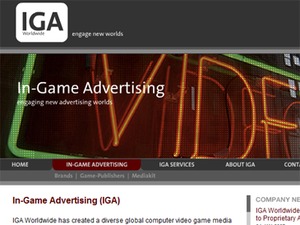
All of this is lovely, but what's it got to do with my game?
So why would a company put this much thought into what you might eat for breakfast or watch after dinner? Simple - it is money in the bank, and it's a relatively untouched field. In-game advertising expenses in 2005 amounted to a paltry $56 million, which is barely a blip on the advertising radar. In comparison, a company could easily spend $2 million on a single 30-second spot during the Super bowl on a local US network.However, that market is only going to go up. Currently, video games are listed as the number one way to target males age 18-35, who often eschew prime-time TV to get a frag-fest in with some mates on Gears of War or Counter-Strike. As consoles and PCs become more of a family home-entertainment centre, the market is expected to rise sharply. By 2010, the lowest estimate is about $730 million, and some firms peg it as high as $1.8 billion.
One of the top rules of business is "Go where the customers are." Video game revenue in 2005 was up to over $10 billion, which is no small chunk of change. With that in mind, it's understandable why an advertiser would want to hit us where we're most likely to actually see things. Computer-based advertising is a tremendous business unto itself; one only has to look at the blazing success of Google to understand that.


Left - Microsoft's Windows Media Center is bringing PCs into the living room slowly but surely. Right - Counter-Strike is still the most popular online game in the world.
Turnabout is fair play
In the past (and still in some current game types), publishers were the ones willing to hand over a bit of coin to use the brand names of the industry's heavyweights. Sports games paid Nike and Adidas for logos, racing games handed cash to Ford and BMW to use product likenesses. At best, IGA was a wash where a publisher was plugging one of its own products, or perhaps got a cross-marketing deal. The concept of applying products for a more realistic feel even got a term - Kmart realism.My, how times have changed. With the explosion of the digital home, video game publishers are looked at as the next great frontier, and many companies are throwing cash at their feet. For instance, take a look at the deals that Ubisoft received for Splinter Cell: Chaos Theory. Axe Body Spray paid a princely sum to have its logo on a glowing billboard in the game. David Rubin, the Senior Brand Manager for Axe, had this to say: "Axe works with developers to create in-game advertising because it is an extremely effective way to reach the 18-34 year-old male audience. It's just that simple."


Left - Splinter Cell: Chaos Theory and Axe Body Spray. Right - IGA Worldwide, one of the new breed of ad agency.
What can be done with all that? A lot of things, namely paying for the sharply increasing development costs. Developing a game for a 7th generation (PS3, Xbox 360) console can cost $20 million easily just in the basic development costs - so a game that can't sell at least 100,000 copies is unlikely to even make back basic expenses that the publisher had to cover while that money was being paid to the devs. Decreasing that figure by a third could promote publishing houses to be able to take quite a few more risks at more niche games.
Of course, we have to account for the IGA firms that need to take their cuts...
The...Who?
With such a rich history, lucrative profits and even benefits to the target audience, it's easy to see why in-game advertising has become such a popular subject matter. Half of the time, we as consumers don't even notice the effort put in to slide brand names under our noses, and that's why the marketers get paid the big bucks. Advertising isn't an art form of who can shout the loudest - rather, it's a delicate balance of who can say the least whilst getting their point across.The big boom in video game sales has started to draw the same sharks that reside in the waters of any other industry. The newest feature to IGA is certainly the existence of separate advertising agencies. In all of the examples listed in the history, there was one thing in common. Advertising was either a developer and / or publisher issue, or it was a deal clearly hammered out between the game makers and the company directly sponsoring the product. This forms the concept of targeted ads, an idea we'll get into in one moment.
Ad agencies like IGA Worldwide, the company behind Battlefield: 2142 are the captains paid to ferry the adverts from companies over the violent seas of the video game world. Though IGA:W is certainly the biggest, there are other smaller ones - such as Adscape Media, recently rumoured to be bought by Google.
The existence of these middle-men has not only changed the profit structures, but also changed how in-game advertising is done in general. Shall we take a look?

MSI MPG Velox 100R Chassis Review
October 14 2021 | 15:04








Want to comment? Please log in.